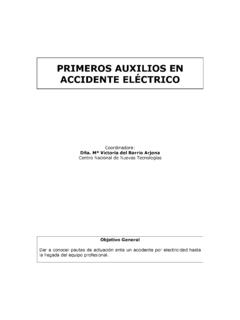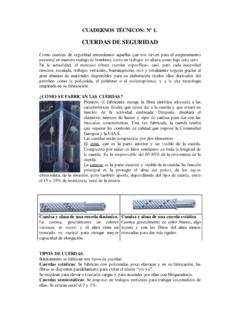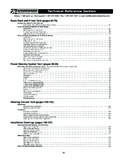Transcription of on technical rescue procedures. THIS GUIDE IS …
1 this Field Operations GUIDE contains specific informationon technical rescue procedures . this GUIDE IS NOT ALL INCLUSIVE!It is intended to be used as a tool for training and forquick field reference. Refer to current training manualsand your department policies for detailed is no substitute for regular, quality, hands-ontraining by a qualified techniques and procedures illustrated in this GUIDE followNFPA standards and OSHA regulations as much as GUIDE can be used by rescuers at all skill levels but wasspecifically developed for fully qualified technical rescuetechnicians. Special operations are inherently dangerous andserious injury or fatality may result from improper performanceof these techniques. The author accepts no responsibility fordamage, loss, injury or death resulting from informationcontained in or omitted from this to the Phoenix Fire Department and everyone who helpedmake this GUIDE possible.
2 Special thanks to my friend Ron Jamison forhelping to write this GUIDE , Kathy Darrow for editing and to GeorgeDrees, Ken Phillips and Jim Frank for great ideas and GUIDE is dedicated to all those people who go the extra inchevery day to make themselves better handbook is based on the Phoenix Fire Department and ArizonaState Fire Marshall s Office technical rescue 0-9675238-4-2 Third Edition October 2003 Illustrations and text copyright 1999-2003 Tom Pendley. All rights reserved. No reproduction, storage or transmission without written permission of the by Desert rescue Research. Photos by Tom Pendley and Glenn art, text layout and design by Glenn Standards2 Risk Management3 Incident Management4 Time Management6 Rope rescue Rope Command Checklist7 Personal Protective Equipment8 Terrain Types9 Mountain rescue Decision Tree10 Basic Life Safety Knots11 Load Releasing Hitch (LRH)
3 15 Personal Purcell Prusik System16 Self Rescue18 Patient Packaging19 Low Angle Evacuation20 Anchor Systems21 Back-Tie Anchors23 Directional Anchors24 Structural Anchors25 Fixed Belay for Edgemen26 Edge Protection27 Tandem Prusik Belay Setup28 technical Evacuation30 technical Evacuation Commands33 technical Evacuation Lower34 technical Evacuation Raise35 Steep Angle Evacuation36 High Angle Litter Rigging37 High Angle Evacuation38 Mechanical Advantages39 Ganged Mechanical Advantage41 Conversion from Lower to Raise 42 Knot Passing43 Mid-Face Litter Scoop46 rescue Pick-off48 Rescuer Based Pick-off50 Team Based Pick-off55 Confined Space RescueCon Space Command Checklist58 Con Space Definitions60 Con Space Entry Safety Checklist61 Personal Protective Equipment62 Supplied Air Station Operation63 Remote Air Cart64 Communication Position65 Intercom66 Atmospheric Monitoring67 Ventilation68 Extrication Device72 rescue Tripod and Winch73 Winch Cable Setup75 rescue Tripod and Pulley System 76 Aerial Apparatus77 Swiftwater RescueSwiftwater Command Checklist79 Equipment80 Swiftwater rescue Comm82 Swiftwater Hazards83 Safe Swimming Position84 Shore-Based rescue : Reach85 Shore-Based rescue : Throw87 Shallow Water Crossing: Wade89 Boat Operations: Row91 Boat on Highline94 Strong Swimmer rescue .
4 Go97 Helicopters and Swiftwater100 Trench RescueTrench Command Checklist101 Trench Incident Site Setup103 Trench Definitions104 Trench Hazards105 Hydraulic Speed Shore System106 Pneumatic Shore Placement109 Timber Shore Step-by-Step111 ContentsKey procedures in redStructural CollapseStructural Collapse Checklist116 Task Level Checklist117 SAR Marking System119 Cut Station121 Material Capacities and Weights 123 Airbag Operation124T Spot Shore125 Ellis Clamps126 Two Post Vertical Shore127 Laced Post Shore128 Alternate Door/Window Shore129 Standard Door / Window Shore 13060 and 45 Solid Sole Rakers131 Flying Raker134 Sloped Floor Shoring135 Helicopter OperationsHelo Ops Command Checklist139 Helicopter Flight Risk Score140 Landing Zone Safety141 Rescuer Safety142 Power On Insertions143 Longline Use Decision Tree145 Longline/Short Haul procedures 146 Capewell Release Mechanism148 Litter Rigging for Longline149 Emergency Procedures150 Sling Loading Equipment150 rescue Medical SituationsCrush Syndrome151 Suspension Trauma152 Hypothermia153 Appendices154 ContentsKey procedures in redSwiftwater rescue Command ChecklistPhase I: Size upPrimary AssessmentSecure witness Determine location, number & condition of victimsIdentify immediate hazardsWater level rising or falling (mark waterline)Surface loads (debris), hydraulics, hypothermiaSecondary AssessmentAssess need for additional personnel and equipment Assess need for additional equipment (boat) rescue mode or recovery modePhase II.
5 Pre- rescue operationsMake general area safe ( , traffic and crowd control) Make rescue area safe Assign safety officerAssure team response to opposite bankPersonal protective equipment within 10 ft. (3m) of waterAssign downstream bag throwersAssign upstream spottersForm incident action planReach, throw, wade, row, go, helicopterBackup plans ( , paddle team with boat)Subject PFD and helmet Pre- rescue briefingPhase III: rescue operationsImplement primary action planMake contact with subject Apply protective equipment Remove subject to safe areaTransfer to ALS, consider hypothermia ( )Phase IV: TerminationPersonnel Accountability Report (PAR)Collect water samples to assess contaminationConsider decontaminating rescuersSwiftwater RescueCommand Checklist79 Personal Protective Equipment Water conducts heat away from the body 25 times fasterthan air of the same RescuePersonal Protective Equipment80 Footwearshould be solidand give ankle protectionThrowbagLoop of throw rope Do not put around wristWetsuitWhistleWater rescuehelmetPersonal flotationdevice (PFD)
6 rescue knifeTeam EquipmentSwiftwater RescueTeam Equipment81 SCBAP addleHose Inflation KitLine GunStockTriggerString compartmentFloating andnon-floatingprojectilesSternHandlesFi ll portsThwartMain chambersBowD ringattachment pointsInflatable rescue BoatSwiftwater rescue CommunicationsWhistle blastsOne blast = stop, look at meTwo blasts = begin action agreed upon orindicated by whistle blowerThree blasts repetitive = distress, need helpHand signalsOne arm in the air = I need helpOne hand on top of head = I am okSwiftwater RescueCommunications82I need help!I m okSwiftwater Hazards Low head dam/hydraulics Strainers Hypothermia Floating debris Foot entrapment Stationary objects Panicked swimmersRiver orientation Rescuer facing down streamMethods of effecting a rescue in order of use/risk: ReachLow risk Throw Wade Row Go HeloHigh risk Do not go within 10 ft.
7 (3m) of the water without a PFD on!Swiftwater RescueHazards/Risks83 Down riverUp riverCurrentRiver rightRiver leftSafe Swimming PositionIf you get swept away, assume safe swimming position andnavigate with ferry angle1. Feet first, facing Knees bent with feet slightly lower than Set proper ferry Angle body with head pointed 45 degrees toward thedesired Stroke backward to help Look for eddy and get set up well in Avoid strainers. If not possible to avoid, swim hard head firstand attack up and over RescueSafe Swimming Position and Ferry Angles841342 Current directionCurrent directionShore-Based rescue : ReachReach with an object such as a pikepole or paddle1. Lay flat on the ground so as not to get pulled Reach as far out as Yell to get the subject s with an inflated fire hose in low head dam situationsand bridge rescues1.
8 Connect as many sections of hose togetheras Cap one Install the inflation manifold to the other Tighten all Assemble air bottle and Inflate hose to 50 to 60 Form bight in end of hose and tie Consider attaching PFD to end of Push hose out to manifoldSwiftwater RescueShore-Based rescue : Reach85 Relief valveAjax regulator and hoseConnection ring2-1/2 in. maleAir inlet and valve2-1/2 in. female SCBAS hore-Based rescue : ReachReach subject with object Pike pole Paddle Tree branch Inflated fire hoseOther rescue options Flotation device tied to rope held by rescuers between riverleft and river right Boat on highline: track line must be up river from hydraulicand boat must be kept straight and away from face ofhydraulic with downstream control lines Two boat access with downstream brake boat Remember aerated water reduces prop efficiency Lead boat must never contact face of hydraulic!
9 River wide hydraulic (low head dam) Swimmers and boaters can identify this hazard fromupriver by seeing a horizon line down RescueShore-Based rescue : Reach86 Retaining wallSubjectInflated fire hoseBend over first three feet of hose and tie off forming bightFace Rescuer shouldlay flat to avoid being pulled inOutwashBackwashBoil lineShore-Based rescue : Throw1. Choose a strategic spot to set up to throw Get and keep eye contact with the subject .3. Aim for the subject s head or slightly up Make a strong underhand throw when the subject is in thetarget Carefully bring the subject to an eddy or the best landingspot you can Be ready to make a second Do not wade into current over your knees Consider a belay line for the rescuer throwing the bag if theshore is sloping and or if there is risk of the rescuer gettingpulled in If the subject does not have a PFD on they will plane underin strong current.
10 Try to give a moving belay and pull them ingradually Never count on the victim to participate in their RescueShore-Based rescue : Throw87 Shore-Based rescue : ThrowSwiftwater RescueShore-Based rescue : Throw88Ta rget zoneThrow at or just behind the subjectCurrent directionBring subjectinto eddy ifpossiblePut rope overshoulder oppositeof the shore you want to land onfor proper ferryangleEddyConsider a belay for thebag throwerShallow Water Crossing: WadeSwiftwater RescueShallow Water Crossing89 Paddle orpike poleWedge or V formationCurrent directionLine astern formationPoint personCurrent direction Do not enter currenthigher than knee deep Keep the formationheaded straight into thecurrent Support the person infront of you Get a solid footplacement each time youmove your foot Do not rush Abort and return toshore before gettingswept awayShallow Water Crossing to a Vehicle1.







